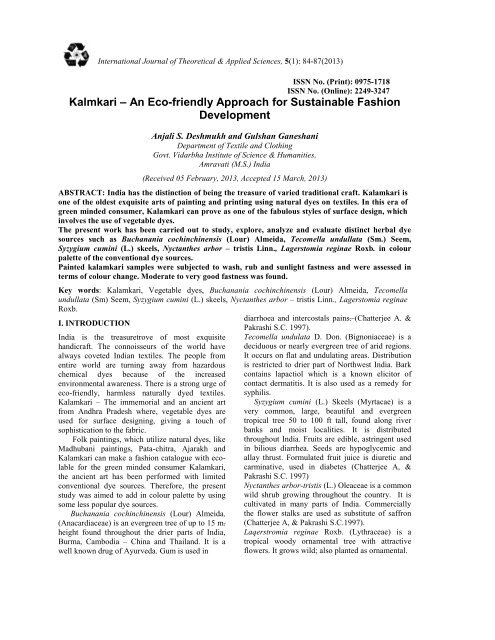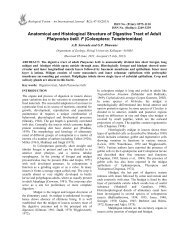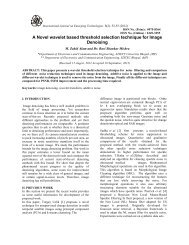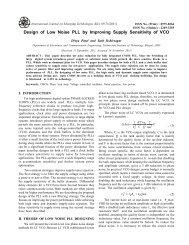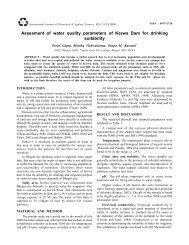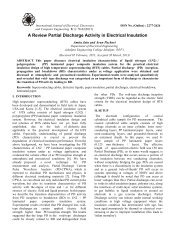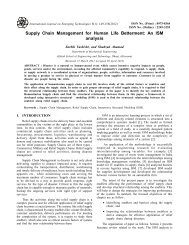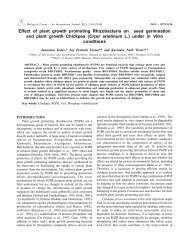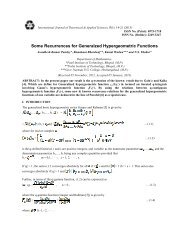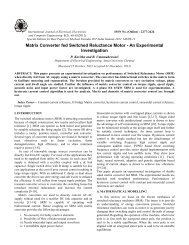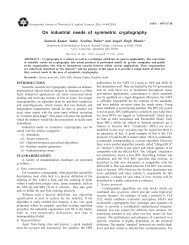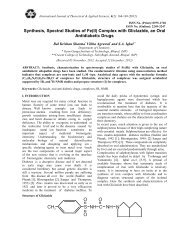Kalmkari â An Eco-friendly Approach for Sustainable Fashion ...
Kalmkari â An Eco-friendly Approach for Sustainable Fashion ...
Kalmkari â An Eco-friendly Approach for Sustainable Fashion ...
You also want an ePaper? Increase the reach of your titles
YUMPU automatically turns print PDFs into web optimized ePapers that Google loves.
ISSN No. (Print): 0975-1718<br />
ISSN No. (Online): 2249-3247<br />
<strong>Kalmkari</strong> – <strong>An</strong> <strong>Eco</strong>-<strong>friendly</strong> <strong>Approach</strong> <strong>for</strong> <strong>Sustainable</strong> <strong>Fashion</strong><br />
ISSN No. (Print) : 0975-1718<br />
Development<br />
<strong>An</strong>jali S. Deshmukh and Gulshan Ganeshani<br />
Department of Textile and Clothing<br />
Govt. Vidarbha Institute of Science & Humanities,<br />
Amravati (M.S.) India<br />
(Received 05 February, 2013, Accepted 15 March, 2013)<br />
ABSTRACT: India has the distinction of being the treasure of varied traditional craft. Kalamkari is<br />
one of the oldest exquisite arts of painting and printing using natural dyes on textiles. In this era of<br />
green minded consumer, Kalamkari can prove as one of the fabulous styles of surface design, which<br />
involves the use of vegetable dyes.<br />
The present work has been carried out to study, explore, analyze and evaluate distinct herbal dye<br />
sources such as Buchanania cochinchinensis (Lour) Almeida, Tecomella undullata (Sm.) Seem,<br />
Syzygium cumini (L.) skeels, Nyctanthes arbor – tristis Linn., Lagerstomia reginae Roxb. in colour<br />
palette of the conventional dye sources.<br />
Painted kalamkari samples were subjected to wash, rub and sunlight fastness and were assessed in<br />
terms of colour change. Moderate to very good fastness was found.<br />
Key words: Kalamkari, Vegetable dyes, Buchanania cochinchinensis (Lour) Almeida, Tecomella<br />
undullata (Sm) Seem, Syzygium cumini (L.) skeels, Nyctanthes arbor – tristis Linn., Lagerstomia reginae<br />
Roxb.<br />
I. INTRODUCTION<br />
International Journal of Theoretical & Applied Sciences, 5(1): 84-87(2013)<br />
ISSN No. (Online) : 2249-3247<br />
India is the treasuretrove of most exquisite<br />
handicraft. The connoisseurs of the world have<br />
always coveted Indian textiles. The people from<br />
entire world are turning away from hazardous<br />
chemical dyes because of the increased<br />
environmental awareness. There is a strong urge of<br />
eco-<strong>friendly</strong>, harmless naturally dyed textiles.<br />
Kalamkari – The immemorial and an ancient art<br />
from <strong>An</strong>dhra Pradesh where, vegetable dyes are<br />
used <strong>for</strong> surface designing, giving a touch of<br />
sophistication to the fabric.<br />
Folk paintings, which utilize natural dyes, like<br />
Madhubani paintings, Pata-chitra, Ajarakh and<br />
Kalamkari can make a fashion catalogue with ecolable<br />
<strong>for</strong> the green minded consumer Kalamkari,<br />
the ancient art has been per<strong>for</strong>med with limited<br />
conventional dye sources. There<strong>for</strong>e, the present<br />
study was aimed to add in colour palette by using<br />
some less popular dye sources.<br />
Buchanania cochinchinensis (Lour) Almeida,<br />
(<strong>An</strong>acardiaceae) is an evergreen tree of up to 15 m.<br />
height found throughout the drier parts of India,<br />
Burma, Cambodia – China and Thailand. It is a<br />
well known drug of Ayurveda. Gum is used in<br />
diarrhoea and intercostals pains. (Chatterjee A. &<br />
Pakrashi S.C. 1997).<br />
Tecomella undulata D. Don. (Bignoniaceae) is a<br />
deciduous or nearly evergreen tree of arid regions.<br />
It occurs on flat and undulating areas. Distribution<br />
is restricted to drier part of Northwest India. Bark<br />
contains lapactiol which is a known elicitor of<br />
contact dermatitis. It is also used as a remedy <strong>for</strong><br />
syphilis.<br />
Syzygium cumini (L.) Skeels (Myrta cae) is a<br />
very common, large, beautiful and evergreen<br />
tropical tree 50 to 100 ft tall, found along river<br />
banks and moist localities. It is distributed<br />
throughout India. Fruits are edible, astringent used<br />
in bilious diarrhea. Seeds are hypoglycemic and<br />
allay thrust. Formulated fruit juice is diuretic and<br />
carminative, used in diabetes (Chatterjee A, &<br />
Pakrashi S.C. 1997)<br />
Nyctanthes arbor-tristis (L.) Oleaceae is a common<br />
wild shrub growing throughout the country. It is<br />
cultivated in many parts of India. Commercially<br />
the flower stalks are used as substitute of saffron<br />
(Chatterjee A, & Pakrashi S.C.1997).<br />
Laqerstromia reginae Roxb. (Lythraceae) is a<br />
tropical woody ornamental tree with attractive<br />
flowers. It grows wild; also planted as ornamental.
Deshmukh and Ganeshani 85<br />
II. MATERIALS AND METHODS<br />
100% gray cotton was used as textile substrate.<br />
Buchanania cochinchinensis (Lour) Almeida.<br />
(<strong>An</strong>acardiaceae) gum, Tecomella undulta D. Don<br />
(Bignoniaceae) leaves, Laqerstromia reginae Roxb.<br />
(Lythraceae) leaves, Nyctanthes arbor- tristis L<br />
(Oleaceae) bark and syzygium cumini (L.) Skells<br />
(Myrtaceae) fruits were used as dye source.<br />
All three types of mordant’s i.e. vegetable, metal<br />
and chemical were tried. Pomegranate rind (Punica<br />
granatum Linn.), babul bark (Acacia arabica Linn.)<br />
and baby harda fruits ( Terminalia Chebula Linn.)<br />
were selected as vegetable mordants. Kasim karam<br />
(Iron filling and jaggary) and Alum were used as<br />
metal mordants, while sodium hydroxide used as<br />
chemical mordant. For extraction of gum of<br />
Buchanania cochinchinensis (Lour) Almeida, bark<br />
of Nyctanthes arbor – tristis, and leaves of<br />
Lagersrtomia reginae were dried & powdered 5 gms<br />
of powder was soaked <strong>for</strong> 24 hours in 100 ml of<br />
water and then heated <strong>for</strong> 30 minutes at 40 0 C, on<br />
water bath, filtered and filtrate used as dye source. 5<br />
gms dried and powdered leaves of Tecomella<br />
undulata were soaked <strong>for</strong> 24 hours in 100 ml of<br />
water. Extraction was carried out <strong>for</strong> 60 minutes at<br />
40 0 C, volume maintained by adding water, filtered<br />
and filtrate used <strong>for</strong> dyeing. 100 gms of fresh fruits<br />
of syzygum cumini were macerated and seeds<br />
removed to the pulp 100 ml of water was added and<br />
heated at 40 0 C <strong>for</strong> 30 minutes, filtered & filtrate use<br />
as dye.<br />
A. Preparation of Stock solution from mordants<br />
2 gm of selected vegetable mordants were soaked<br />
<strong>for</strong> 12 hrs in 25 ml of water each, then boiled <strong>for</strong> 2<br />
minutes and sieved to remove the residue. 2 gm of<br />
alum was dissolved in 25 ml boiling water.<br />
Kasimkaram (Black solution) was use to get black<br />
colour.<br />
B. Pretreatment with Harda<br />
100 gm Harda powder was soaked in water <strong>for</strong> 24<br />
hrs and then homogenized with 1 lit of buffalo milk.<br />
This mixture was used <strong>for</strong> pretreatment of scoured<br />
grey cotton. Selected designs were traced. Dyes<br />
extracted were mixed with mordant solution in<br />
definite proportion. Table 1 shows the ratio of dye:<br />
mordant and colour range produced.<br />
Table 1: Preparation of Colour Range from Selected Dye Sources.<br />
Dye Source Dye extract & Mordant mixtures Ratio (ml)<br />
Dye:Mordant<br />
Colour<br />
range<br />
Colour range<br />
produced<br />
B. lanzan Bl + Sodium hydroxide Bl Chocolate brown<br />
T. undulata Tu + alum 50:2.5 Tu 1 Yellow ochar<br />
Tu + alum + babul bark 50:2.5:2.5 Tu2 Orange yellow<br />
Tu + alum + babul bark 50:2.5:0.5 Tu3 Orange yellow<br />
Tu + kasimkaram 50:2.5 Tu4 Wood brown<br />
Tu + kasimkaram 50:5 Tu5 Brown<br />
S. cumini Sc + alum + kasimkaram 50:2.5:5 Sc1 Greenish gray<br />
Sc + alum + anarchal + Na 50:2.5:2.5:5 Sc2 Tone of yellow<br />
Sc + alum + Na + anarchal + kasimkaram 25:2.5:10:2.5:1.5 Sc3 Tone of brown<br />
Sc + alum + anarchal + kasimkaram 50:5:10:1 Sc4 Tone of green<br />
N. arbor tristis Na + alum + kasimkarm 50:2.5:0.5 Na Wood yellow<br />
L. reginae Lr + anarchal 50:10 Lr1 Tone of yellow<br />
Lr + kasimkarm 50:2.5 Lr2 Tone of brown<br />
Lr + babul bark 50:5 Lr3 Brown
C. Kalamkari Painting<br />
As the name implies ‘Kalam’ made of bamboo stick<br />
was used in filling the selected traditional designs<br />
traced on cotton fabric. To fill the various <strong>for</strong>ms of<br />
design; colour and different shades were prepared<br />
by using mordants along with the dye extracted<br />
from the selected dye sources.<br />
III. RESULTS AND DISCUSSION<br />
Out of five vegetable dyes selected <strong>for</strong> present<br />
study, only Nyctanthes arbor- tristis is traditionally<br />
used as dye source (<strong>An</strong>onymous 2000, Siva 2007,<br />
Bhatnagar 2008) Syzygium cumini has been used as<br />
a textile dye (Mahanta and Tiwari 2005) while rest<br />
of the three sources are exploited <strong>for</strong> the first time as<br />
dye. However use of all dyes <strong>for</strong> Kalamkari is the<br />
first ef<strong>for</strong>t of its type. Here an attempt is also made<br />
to standardize the ratio of dye and mordant/s <strong>for</strong><br />
colour range.<br />
Colour Obtained<br />
Chocolate brown<br />
Yellow OChar<br />
Orange yellow<br />
Orange yellow<br />
Wood brown<br />
Brown<br />
Greenish gray<br />
Tone of yellow<br />
Tone of brown<br />
Tone of green<br />
Wood yellow<br />
Tone of yellow<br />
Tone of brown<br />
Brown<br />
Deshmukh and Ganeshani 86<br />
A. Washing fastness<br />
From Table 2 it is clear that the results obtained<br />
from Buchanania cochinchinensis (Lour) Almeida<br />
(Bl) rated moderate fastness towards washing.<br />
Range of colours orange and brown imparted by<br />
Tecomela undulata i.e. Tu1, Tu2 and Tu5 rated<br />
good fastness, where as Tu4 rated excellent wash<br />
fastness, and Tu3 rated fairly good fastness.<br />
Fastness varies with the change in mordant used.<br />
Range of colour obtained with syzygium cumini has<br />
very good fastness while using Sc1, Sc2, Sc3, on<br />
cotton and Sc4 rated fairly good fastnes. Nyctanthes<br />
orbortristis painted cotton rated good fastness when<br />
subjected to washing. Range of colours produced<br />
with Laqerstomia reginae in combination with<br />
vegetable mordants rated to excellent colour<br />
fastness towards cotton painted with Lr2, Lr3 and<br />
Lr1 respectively.<br />
Table 2: Determination of colour fastness to Washing, Rubbing and Sunlight.<br />
Range of Colour<br />
obtained<br />
Washing<br />
Sunlight<br />
Rubbing<br />
B1 3 4 5 5<br />
Tu1 4 4/5 4/5 4/5<br />
Tu2 4 4/5 4/5 4/5<br />
Tu3 3/4 4/5 4/5 4/5<br />
Tu4 5 5 4/5 4/5<br />
Tu5 4 4/5 4 4<br />
Sc1 4/5 4/5 4 4<br />
Sc2 4/5 4 4/5 4/5<br />
Sc3 4/5 4/5 4/5 4/5<br />
Sc4 3/4 4 4/5 4/5<br />
Na 4 5 4 4/5<br />
Lr1 5 5 4/5 4/5<br />
Lr2 4/5 5 4 4<br />
Lr3 4/5 4/5 4/5 4/5<br />
Dry<br />
Wet
Deshmukh and Ganeshani 87<br />
B. Sunlight fastness<br />
Painted fabric rated good <strong>for</strong> B1, as a natural<br />
colourant. Very good fastness was found <strong>for</strong> the<br />
Tu1, Tu2, Tu3 and Tu5 where as it was rated<br />
excellent <strong>for</strong> Tu4. Allmost all painted sample<br />
showed very good fastness when Syzygium cumini<br />
was used as a colour source. Nyctanthes arbortristis<br />
painted cotton rated excellent light fastness towards<br />
wood yellow colour. Colour extract of Lagerstomia<br />
reginae leaves rated excellent to very good fastness<br />
towards Lr1, Lr2 and Lr3 respectively.<br />
C. Rubing fastness<br />
Buchanania cochinchinensis (Lour) Almeida gum<br />
produced chocolate brown colour which rated<br />
excellent dry and wet rubbing fastness to painted<br />
fabrics.<br />
Range of yellow and brown i.e. Tu1, Tu2, Tu3, Tu4<br />
produced with Tecomela undulata showed very<br />
good dry and wet rubbing fastness. Except Tu5<br />
which rated good fastness. Table also represents the<br />
wash fastness of cotton painted with Loqerstromia<br />
reginae yellow and brown produced which rated<br />
good to very good fastness.<br />
IV. CONCLUSION<br />
The present work aims to highlight the revival and<br />
promotion of the ancient art. Kalamkari by using<br />
less popular and new vegetable sources <strong>for</strong> painting.<br />
Taking the global environmental awareness into<br />
consideration vegetable mordants such as Babul<br />
bark, <strong>An</strong>ar Chal and Alum was used. Result show<br />
that vegetable mordants can be successfully used as<br />
substitute <strong>for</strong> metal and chemical mordants.<br />
Vegetable dyesources and mordants yielded variety<br />
of colours and shades. The colours when used <strong>for</strong><br />
kalamkari on cotton showed good to excellent<br />
fastness. Hence the dye sources can be explored<br />
commercially to design interesting value added<br />
fashion products.<br />
REFERENCES<br />
[1]. <strong>An</strong>onymous, 2000, Jamun, at<br />
http://www.haryana/online.com/JamunEugenia<br />
jambolana-Flora-Syzygium cumini/Trees-Haryana<br />
online-0 India.htm.<br />
[2]. Chatterjee A. & Pakrashi S.C. (1997) National<br />
Institute of Science communication, New Delhi,<br />
1997. Vol. 3 PP. 150, 186. Vol. 4 PP. 18<br />
[3]. Mahanta & Tiwari, 2005, Natural Dye-yielding<br />
Plants and Indigenous Knowledge on Dye<br />
Preparation in Arunachal Pradesh, Noutherneast<br />
India, Research Communications, Current Science,<br />
vol. 88(9), P.P 1474-1480.<br />
[4]. Siva. R. 2007, Status of Natural Dyes and Dye<br />
Yielding Plants in India. Current Science, Vol.<br />
92(7) p.p 916-925.<br />
[5]. Sunita Bhatnagar 2008, Suitable Solvent fo the<br />
Isolation of Dye from the Flower Stalks of<br />
Nyctanthes arbor tristis, at<br />
http://www.google.com/rise -of Nyctanthes-arbor<br />
tristis as a dye source.htm.


